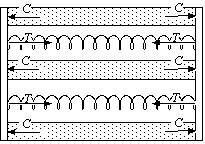
1. Which force, electromagnetic(E), gravitational(G), weak nuclear(WN) or strong nuclear(SN), is primarily responsible for the following: (all correct for credit)
| lighting a campfire. E | inverse beta decay : n + n > p + e . WN |
| bleaching your hair. E | shaving your body. E |
| capture of a neutron in a nucleus. SN | inflating a tire. E |
| splitting DNA in a cell nucleus. E | frying an egg. E |
| rising of a cake. E | melting cheese in a microwave oven. E |
| breaking a bone. E | decay of a tooth. _ E |
2. True or False (all correct for credit)
Two force vectors can "balance" if the magnitude and direction are the same. ....... F
Two force vectors can "balance" and be "equal" at the same time. ........................ F
Two force vectors are "equal" only if the magnitude and direction are the same...... T
Two force vectors with "equal" magnitudes can point in opposite directions. ......... T
Two force vectors can stretch an object if they are "equal". .................................. F
3. If force vectors, F1 = +A , F2 = 2A , F3 = +4A , and F4 , balance, then F4 = 3A .
4. One cm3 of U238 has a mass of 1.8´101 grams. What is the mass of 1´103 m3 of U238 ?
a) 1.8´101 kg b) 1.8´102 kg c) 1.8´103 kg d) 1.8´104 kg e) 1.8´105 kg
density = 1.8´101 grams/ cm3
= (1.8´101 grams/ cm3 )(1 kg/103 grams)( 102 cm/1 m) 3 = 1.8´104 kg/ m3
mass = density*volume = ( 1.8´104 kg/ m3)(1´10-3 m3) = 1.8´101 kg
Two identical springs generate tension forces, T, that act on two stiff (can't bend) sides held apart by three identical bars (shaded).
5. Draw the compression force vectors acting on the sides, generated by the bars, with the appropriate length, direction, and label (C).

6. What is their length (the magnitude C ) ?
a) T, b) 3T, ![]() d)
d) ![]() , e) 4T . The answer
is C =((2/3)T)
, e) 4T . The answer
is C =((2/3)T)
left side vectors: C = C , T = +T.
The balance condition is 3C + 2T = 0
3(C)+2T = 0
3C = 2T
C = (2/3) T
7. An ideal spring, spring constant k , is cut into six pieces.
Three of these pieces are then connected in parallel. What is the spring
constant of the parallel combination?
(hint: treat as two steps) a) k, b) 2k, c) 3k , d)
6k, e) 18k .

8. A spring obeys Hookes law and can be stretched 5 cm by a force of 200 N. What is the slope (with units) of a plot of the force vs. the stretch of this spring? 40 N/cm.
k = slope = DF/Dx = (200 N)/(5 cm) = 40 N/cm
9. A rope with tension, T, passes over a frictionless and massless pulley wheel. What is the magnitude of the force that holds the axle of the pulley wheel in place?.
a) T b) T c) 2T d) 3T e) 2T

T2 = 2T
10. Which statement is true? Springs: a) store forces
and generate energy,
b) store forces and store energy, c) generate forces
and generate energy,
d) generate forces and store energy, e) store
forces but can't generate energy.